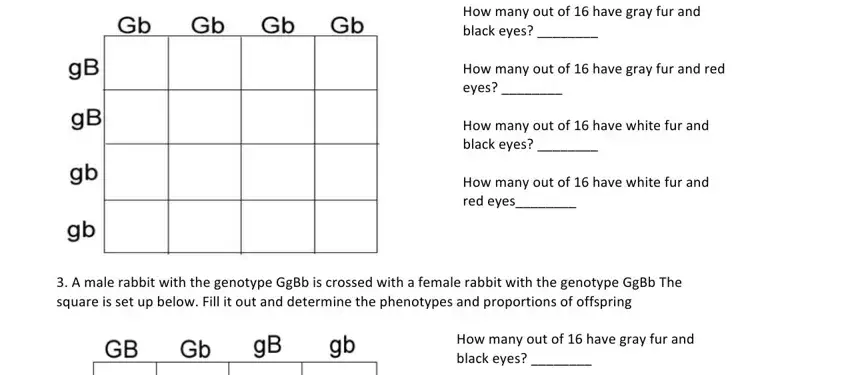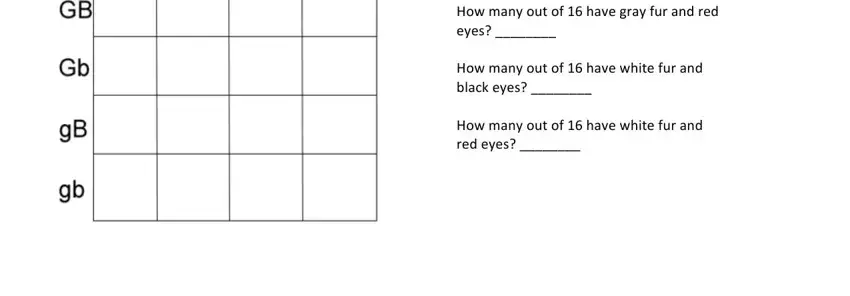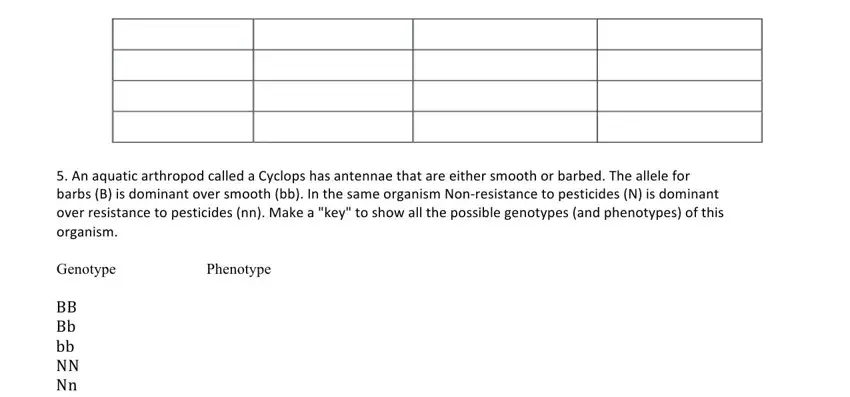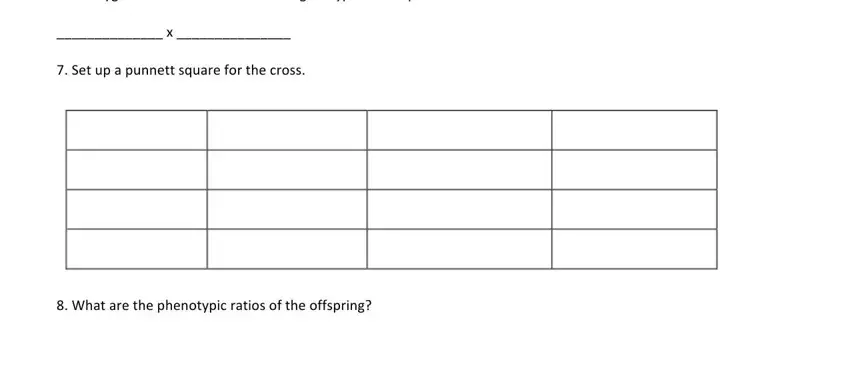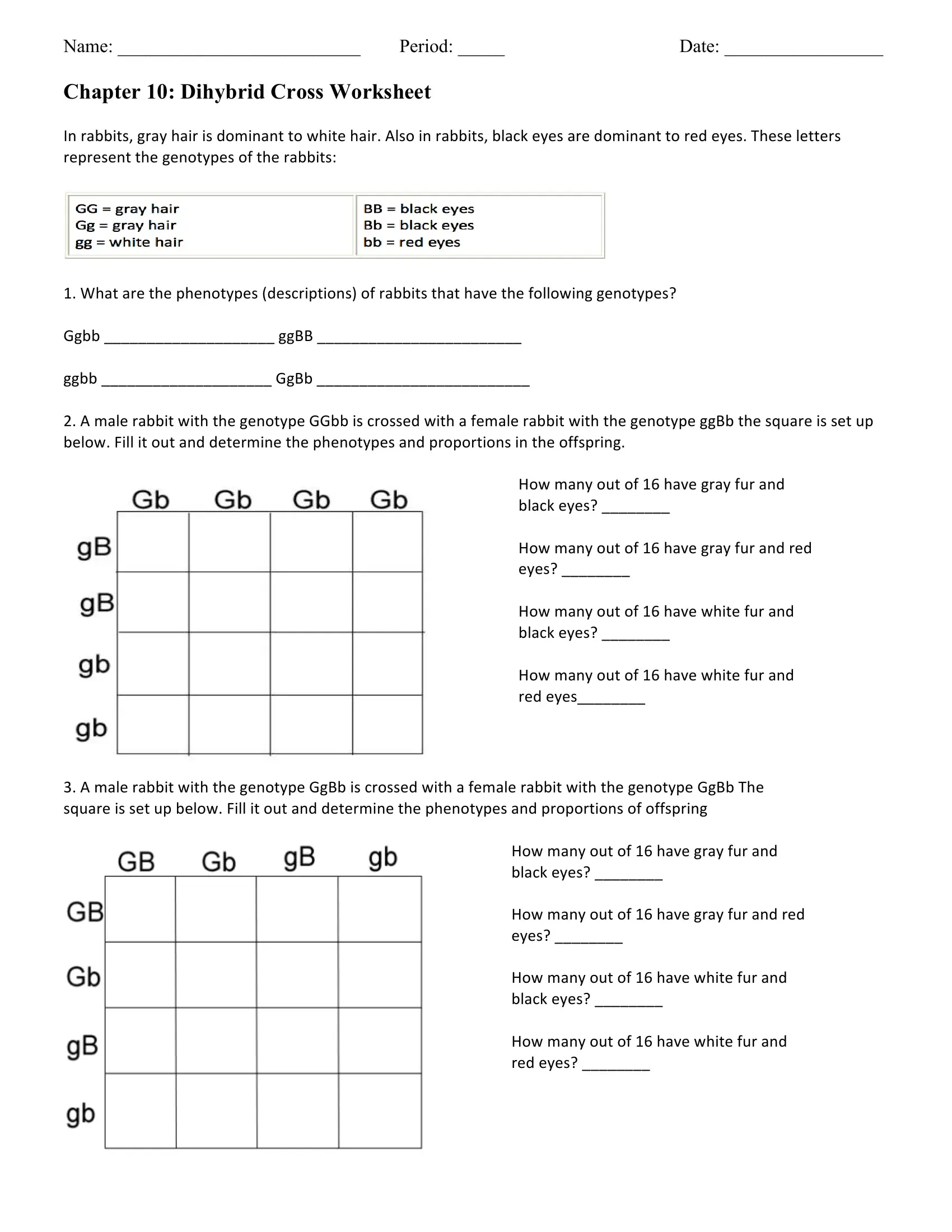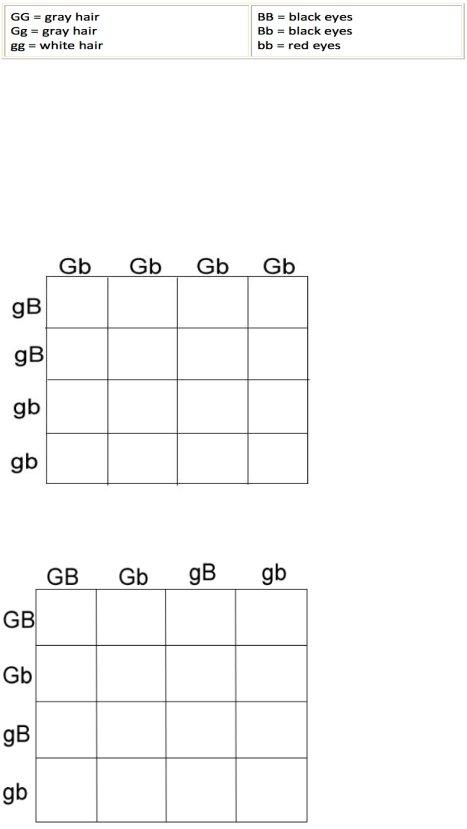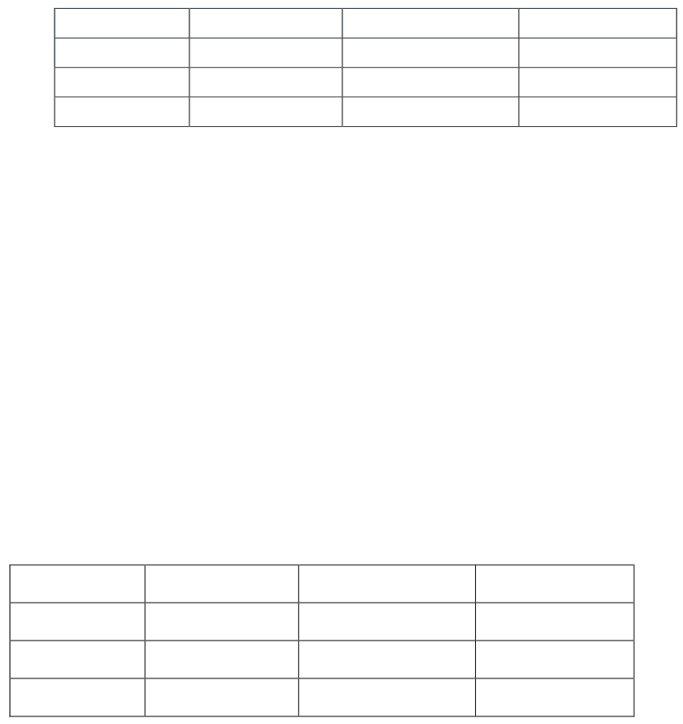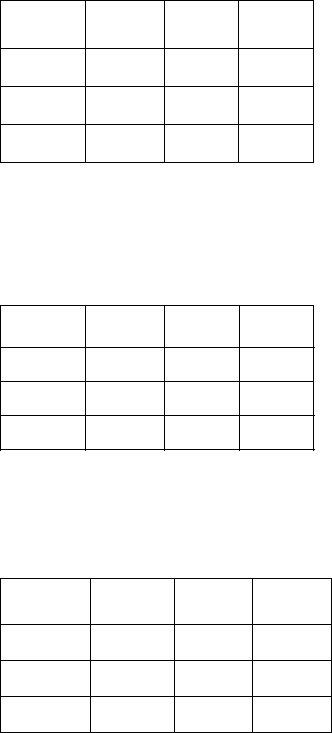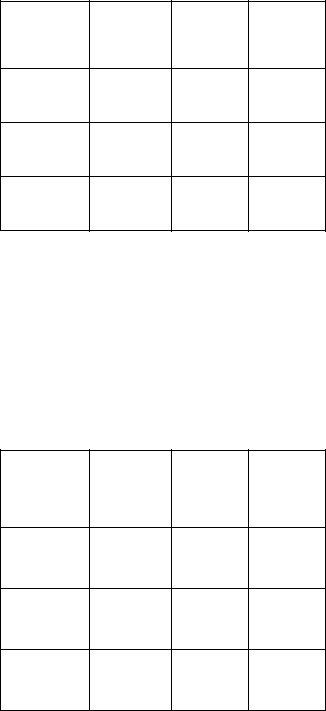Name: __________________________ |
Period: _____ |
Date: _________________ |
Chapter 10: Dihybrid Cross Worksheet
In rabbits, gray hair is dominant to white hair. Also in rabbits, black eyes are dominant to red eyes. These letters represent the genotypes of the rabbits:
1.What are the phenotypes (descriptions) of rabbits that have the following genotypes?
Ggbb ____________________ ggBB ________________________
ggbb ____________________ GgBb _________________________
2.A male rabbit with the genotype GGbb is crossed with a female rabbit with the genotype ggBb the square is set up below. Fill it out and determine the phenotypes and proportions in the offspring.
How many out of 16 have gray fur and black eyes? ________
How many out of 16 have gray fur and red eyes? ________
How many out of 16 have white fur and black eyes? ________
How many out of 16 have white fur and red eyes________
3.A male rabbit with the genotype GgBb is crossed with a female rabbit with the genotype GgBb The square is set up below. Fill it out and determine the phenotypes and proportions of offspring
How many out of 16 have gray fur and black eyes? ________
How many out of 16 have gray fur and red eyes? ________
How many out of 16 have white fur and black eyes? ________
How many out of 16 have white fur and red eyes? ________
4.Show the cross between a ggBb and a GGBb. You'll have to set this one up yourself:
Punnett Square:
5.An aquatic arthropod called a Cyclops has antennae that are either smooth or barbed. The allele for barbs (B) is dominant over smooth (bb). In the same organism Non‐resistance to pesticides (N) is dominant over resistance to pesticides (nn). Make a "key" to show all the possible genotypes (and phenotypes) of this organism.
Genotype Phenotype
BB Bb bb
NN Nn nn
6.A Cyclops that is resistant to pesticides and has smooth antennae is crossed with one that is heterozygous for both traits. Show the genotypes of the parents.
______________ x _______________
7. Set up a punnett square for the cross.
8. What are the phenotypic ratios of the offspring?
DiHybrid Practice Problems
1.In man, assume that spotted skin (S) is dominant over non-spotted skin (s) and that wooly hair (W) is dominant over non-wooly hair (w). Cross a marriage between a heterozygous spotted, non-wooly man with a heterozygous wooly-haired, non-spotted woman. Give genotypic and phenotypic ratios of offspring.
2.In horses, black is dependent upon a dominant gene, B, and chestnut upon its recessive allele, b. The trotting gait is due to a dominant gene, T, the pacing gait to its recessive allele, t. If a homozygous black pacer is mated to a homozygous chestnut trotter, what will be the appearance of the F1 generation?
3.In summer squash, white fruit color (W) is dominant over yellow fruit color (w) and disk‐ shaped fruit (D) is dominant over sphere‐shaped fruit (d).. If a squash plant true‐breeding for white, disk‐shaped fruit is crossed with a plant true‐breeding for yellow, sphere‐shaped fruit,
5.In mice, the ability to run normally is a dominant trait. Mice with this trait are called running mice (R). The recessive trait causes mice to run in circles only. Mice with this trait are called waltzing mice (r). Hair color is also inherited in mice. Black hair (B) is dominant over brown hair (b).For each of the following problems, determine the parent genotypes, determine possible gametes then construct a Punnet square to solve.
a. Cross a heterozygous running, heterozygous black mouse with a homozygous running, homozygous black mouse
Parental genotypes ______________
Possible gametes _____ _____ _____ _____
Offspring phenotypic ratio ________________
b. Cross a homozygous running, homozygous black mouse with a heterozygous running, brown mouse
Parental genotypes ______________
Possible gametes _____ _____ _____ _____
Offspring phenotypic ratio ________________
c. Cross a waltzing brown mouse with a waltzing brown mouse
Parental genotypes ______________
Possible gametes _____ _____ _____ _____
Offspring phenotypic ratio ________________
d. Cross a homozygous running, heterozygous black mouse with a waltzing brown mouse
Parental genotypes ______________
Possible gametes _____ _____ _____ _____
Offspring phenotypic ratio ________________
e. Cross a heterozygous running, brown mouse with a heterozygous running, homozygous black mouse
Parental genotypes ______________
Possible gametes _____ _____ _____ _____
Offspring phenotypic ratio ________________
f. Cross a heterozygous running, heterozygous black mouse with a heterozygous running, heterozygous black mouse
Parental genotypes ______________
Possible gametes _____ _____ _____ _____
Offspring phenotypic ratio ________________
1.Set up a punnett square using the following information:
•Dominate allele for tall plants = D
•Recessive allele for dwarf plants = d
•Dominate allele for purple flowers = W
•Recessive allele for white flowers = w
•Cross a homozygous dominate parent (DDWW) with a homozygous recessive parent (ddww)
2. Using the punnett square in question #1:
a. What is the probability of producing tall plants with purple flowers?
Possible genotype(s)?
b. What is the probability of producing dwarf plants with white flowers?
Possible genotype(s)?
c. What is the probability of producing tall plants with white flowers?
Possible genotype(s)?
d. What is the probability of producing dwarf plants with purple flowers?
Possible genotype(s)?
3.Set up a punnett square using the following information:
• Dominate allele for black fur in guinea pigs = B
• Recessive allele for white fur in guinea pigs =b
• Dominate allele for rough fur in guinea pigs =R
• Recessive allele for smooth fur in guinea pigs = r
• Cross a heterozygous parent (BbRr) with a heterozygous parent (BbRr)
4.Using the punnett square in question #3:
a. What is the probability of producing guinea pigs with black, rough fur?
Possible genotype(s)?
b. What is the probability of producing guinea pigs with black, smooth fur?
Possible genotype(s)?
c. What is the probability of producing guinea pigs with white, rough fur?
Possible genotype(s)?
d. What is the probability of producing guinea pigs with white, smooth fur?
Possible genotype(s)?

